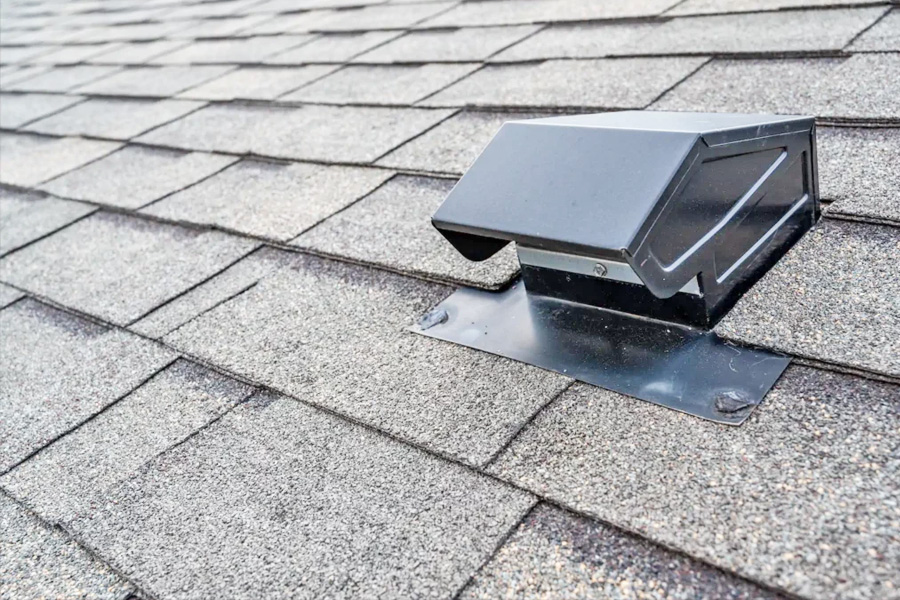A healthy and comfortable home is very important. A good roof that lets air move freely helps with this. Roof ventilation is the system that keeps air flowing in your attic space. A well-designed ventilation system has intake and exhaust vents placed in the right spots. These vents work together to control temperature and moisture. This helps your roof last longer and keeps your home safe.
Understanding the Basics of Roof Ventilation
Roof ventilation is a system designed to regulate the airflow in your attic or roof space, helping to maintain the temperature and moisture levels. Proper roof ventilation allows hot air to escape in the summer and prevents moisture buildup in the winter, which can cause issues like mold growth, ice dams, and deterioration of roofing materials.
There are typically two types of vents used in roof ventilation: intake vents (usually placed along the eaves or soffits) that allow cool air to enter the attic, and exhaust vents (placed near the roof ridge) that let the warm, moist air escape. This balanced flow of air helps to extend the lifespan of your roof, improve energy efficiency, and maintain a healthier indoor environment.
Why Roof Ventilation Matters
Proper roof ventilation is crucial for maintaining the health and longevity of your home. It plays a significant role in protecting your roof from damage, improving energy efficiency, and ensuring a comfortable living environment.
Here’s why ventilation matters for your roof:
Prevents Moisture Damage
Without proper ventilation, moisture from everyday activities like cooking, showering, and even breathing can get trapped in your attic. This excess moisture can lead to the growth of mold and mildew, which can deteriorate wood, insulation, and other building materials. Over time, this can weaken the structural integrity of your roof, leading to costly repairs.
Reduces Heat Buildup
In the warmer months, a poorly ventilated attic can become extremely hot, causing the temperature inside your home to rise. This not only makes your living space uncomfortable but also forces your HVAC system to work harder, increasing energy bills. Proper ventilation allows hot air to escape, keeping your attic cooler and reducing the strain on your cooling system.
Prevents Ice Dams
In colder climates, poor ventilation can contribute to the formation of ice dams. When warm air from your home rises to the attic, it can cause snow on the roof to melt. The water then runs down the roof and refreezes at the eaves, creating ice dams that can damage shingles and lead to leaks. Ventilation helps maintain a consistent roof temperature, preventing this cycle from occurring.
Extends Roof Lifespan
Excessive heat and moisture can cause roofing materials to deteriorate prematurely. Asphalt shingles, for example, can warp and lose their effectiveness, leading to leaks and other issues. By keeping the attic temperature regulated and reducing moisture, ventilation helps extend the life of your roof and reduces the need for frequent repairs.
Improves Indoor Air Quality
Good ventilation helps prevent the buildup of harmful pollutants like mold spores and chemical fumes that can accumulate in a poorly ventilated attic. This improves the overall indoor air quality, making your home healthier for you and your family.
Energy Efficiency
Proper ventilation can help reduce your home’s energy consumption. By allowing hot air to escape in the summer and preventing heat buildup, your cooling system doesn’t have to work as hard, leading to lower energy bills. In the winter, it helps prevent moisture problems that could otherwise lead to energy loss.
In summary, roof ventilation is essential for protecting your home, improving energy efficiency, and maintaining a comfortable living environment. Investing in a proper ventilation system can save you from costly repairs and ensure your roof lasts for many years.
Selecting the Right Ventilation Solution for Your Home
Choosing the right ventilation system for your home is important. You need to think about a few things. These include the design of your home, your climate, and the size of your attic. Each type of roof ventilation system has its advantages and is best suited for specific roof designs and climates. Often, a combination of different vents (like soffit and ridge vents) is used to create a balanced ventilation system.
Here are the different types of roof vents and a brief description of each:
Ridge Vents
Installed along the roof’s peak, ridge vents allow warm air to escape from the attic. They run the entire length of the roof, providing continuous ventilation. Ridge vents are often covered by shingles, making them less visible and more aesthetically pleasing.
Static Vents (Box Vents)
Static vents, also known as box vents or turtle vents, are non-mechanical vents that rely on natural convection to allow hot air to escape from the attic. These vents are typically installed near the roof’s ridge and are spaced out along the roofline.
Turbine Vents
Turbine vents, also known as whirlybirds, have a spinning top that is powered by wind. As the wind rotates the turbine, it pulls warm air out of the attic. They are effective in areas with consistent wind and can enhance ventilation without the need for electricity.
Power Vents
Power vents are motorized vents that use electricity to draw air out of the attic. They are equipped with thermostats or humidistats to activate the fan when certain temperature or humidity levels are reached. Power vents are effective in areas with low wind or extreme temperatures.
Soffit Vents
Installed under the eaves of the roof, soffit vents allow fresh air to enter the attic. They work in conjunction with other types of vents, like ridge vents, to create a balanced airflow by pulling in cooler air from below while warm air escapes through vents at the roof’s peak.
Gable Vents
Gable vents are installed on the exterior walls of a home, near the roof’s peak on the gable ends. They allow air to circulate through the attic by letting out hot air and bringing in cooler air, usually aided by wind. Gable vents are a common feature in homes with gable-style roofs.
Cupola Vents
Cupola vents are decorative structures typically placed on the roof’s ridge or peak. They serve both aesthetic and functional purposes, allowing warm air to escape while adding a charming architectural element to the roof.
Off-Ridge Vents
Similar to ridge vents but shorter in length, off-ridge vents are installed near the roof’s ridge and allow air to escape from the attic. They are typically used when a full-length ridge vent isn’t feasible due to the roof’s design.
Roof Ventilation
In conclusion, roof ventilation is very important for keeping your home safe and energy-efficient. When you learn about the basics, why it matters, and the different types, you can make better choices to protect your home. Good ventilation stops problems like mold growth, ice damming, and too much heat. When you choose a ventilation system, think about airflow, insulation, and if the roofing materials will work well together. It is helpful to talk to a good roofing contractor. They can help you find the best ventilation solution for your needs.




















